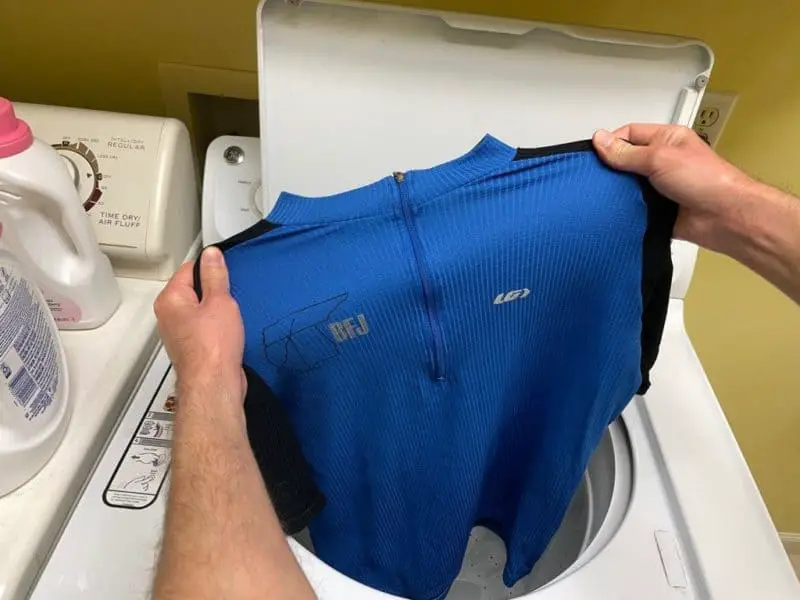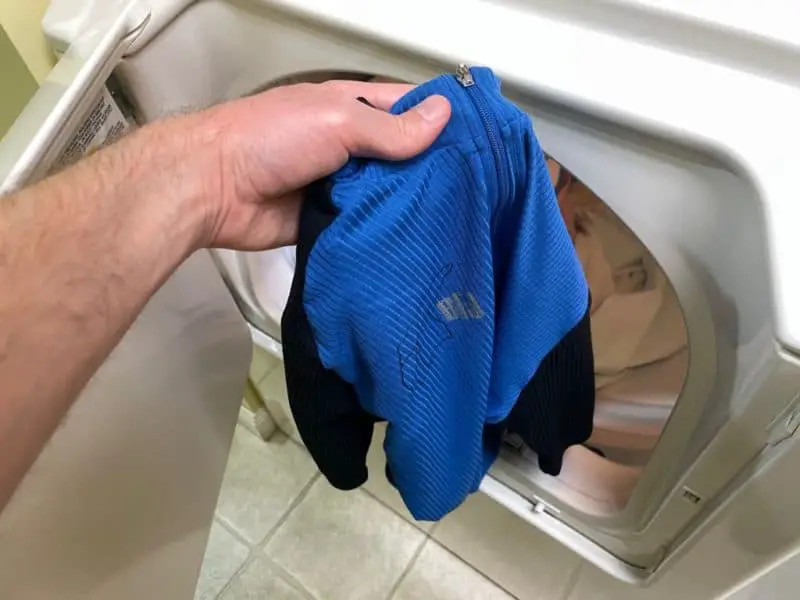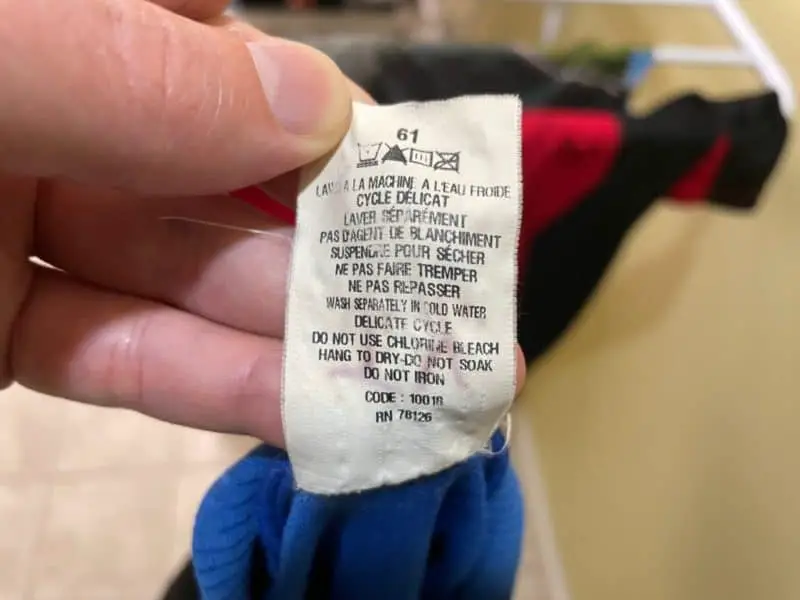When you’re stuck in between sizes the solution has always been to throw your clothes in the dryer and shrink them.
But can you do the same with cycling jerseys?
Can You Shrink a Cycling Jersey?
You can shrink cycling jerseys, but they do not shrink in the same way that regular clothes do. Cycling jerseys are usually made from synthetic materials that are more likely to be damaged by heat exposure, which is the primary method used to shrink clothing. So, you can shrink cycling jerseys, but it’s risky.
Allow me to elaborate. Most people shrink their jeans, t-shirts, and other casual clothing by exposing those clothes to the heat of a dryer or a washer set to warm/hot water.

Tumbling around in a confined space at high temperatures causes the fibers in materials to constrict. Which in turn makes the clothes shrink.
However, different materials react to heat in different ways. Natural fibers are more prone to shrinking than man-made materials.
Fabrics like wool, linen, and cotton will shrink much more than fabrics like nylon, polyester, or lycra. And synthetic materials are more likely to burn or suffer heat damage. Different cycling brands make cycling jerseys from a variety of materials, but most modern cycling jerseys are made of synthetic materials.
The different properties of these synthetic materials are used to give cycling jerseys some of their many great features. Features like their wicking ability and aerodynamic build. However, if your jersey suffers heat damage there is a good chance that it will lose these features.
Should You Shrink a Cycling Jersey? (Will You Ruin It?)
Just because you CAN shrink a cycling jersey doesn’t mean you SHOULD. The high temperatures that it would take to shrink the jersey will more than likely damage it.
And it is not common for shrinking to work well on a cycling jersey. It will affect your jersey’s ability to perform. The fabric can melt and your jersey may come out deformed rather than shrunken. Its aerodynamic makeup, elasticity, and wicking abilities may all be gone.
Even on low heat, the dryer can reduce your jersey’s life span significantly.

A quality cycling Jersey is expensive. It would be a waste to spend all of that money on a good jersey and ruin it.
The best thing to do is to just have your jersey tailored. This way it will be sized perfectly and it won’t come out damaged.
But, if you want to live life on the edge and try to shrink your jersey anyway, here are your options…
How to Shrink a Cycling Jersey
There are a variety of ways to shrink a garment. For a cycling jersey, the best methods to try are soaking it, drying it, or having it tailored. We’ll cover these methods here first, but don’t forget to also check out the section below on whether you SHOULD shrink your jersey.
Tailoring
For the best results possible it is better to have your jersey tailored. If you have access to a sewing machine you can even do it at home.
When shrinking clothes it is almost impossible to tell what size they will be when you’re done. You risk over shrinking them. If your jersey comes out too small then you really won’t have any use for it.
Tailoring your jersey will ensure that it comes out the perfect size. And there is no risk of damaging it.
Take a ride down to your local tailor and drop off your jersey. If you have access to a sewing machine here is a great video that shows you how to tailor it yourself. It is much easier than you’d expect.
Drying
Shrinking a cycling jersey the dryer is a simple process.
1. Turn the jersey inside out.
Turning your jersey inside out helps to avoid fading its color and ruining its design.
2. Wash the jersey in cold water.
It is important to make sure your jersey is clean before you put it in the dryer. Stains, oil, and bacteria can be baked into the material of your jersey. This could alter the material and affect your jersey’s performance.
You also don’t want too much heat on your jersey. The dryer will provide more than enough heat.
If your jersey is already clean you can skip this step.
3. Put it in the dryer
Once it’s done washing make sure it’s still inside out and stick it in the dryer.
Start by drying your jersey on medium heat. If it has not shrunk enough you can put it back in and dial the heat up as necessary.
It is important to do this gradually to avoid over shrinking.
Soaking
1. Fill your sink with hot water
If you want to be safe you can start with warm water. The hotter the water the more of an effect it will have on your jersey. Just make sure the water isn’t boiling.
2. Let it soak
Let your jersey soak for at least 20 minutes. The longer it soaks the more it will shrink. If the water gets cold remove your jersey and replace the water
3. Let your jersey air dry
Do not wring out your jersey, doing so could ruin the fabric. Hang your jersey up to dry and wait until it’s dry to try it on.
How to Keep Your Jersey in Excellent Condition
The life span of your jersey can be measured by how well you take care of it. If you clean your jersey properly and carefully, it will remain in excellent condition. Make sure to take these steps while caring for your jersey.
1. Pre-Wash
If you come home from a ride caked in mud prep your jersey before washing it. Rinse your muddy jersey in cold water. When you’re done, do not ring it out. Ringing out your jersey can damage its fabric.
When it comes to water repellent materials like raincoats, you can stop at the pre-wash. Water repellent treatments wear off over time. Just rinsing the garment in the sink will get it clean enough and prolong its life span.
2. Wash Your Kit Immediately
Be sure to wash your jersey right after you take it off. Leaving it covered in mud and sweat gives bacteria a chance to build up and can damage the stitching. It is best to clean your jersey after every ride. If you don’t want to use the washing machine every time, hand washing can work just as well.
3. Turn Your Jersey Inside Out
Turning your jersey inside out will protect any logos or designs and help prevent the color from fading.
Doing this will also help to get the material that’s been close to your skin extra clean.
4. Only Wash With Other Cycling Gear
Wash your cycling kit together. Do not throw in any of your everyday clothes. Your kit is delicate and washing it with other clothes can cause wear and decrease its life span.
5. Use Mild Soap
Use a delicate detergent on your jersey. Avoid anything that promises whiter whites or bolder colors. These detergents could either bleach the fabric or leave a residue. Any residue left on the material can impair the performance of the jersey.
Avoid fabric softener as well. Fabric softener leaves a residue that can trap oil and odors on cycling gear. Fabric softeners can also damage the elastane that helps give synthetic fabrics their stretch.
Some cycling gear brands, such as ASSOS, sells laundry detergent made specifically for cycling gear. This kind of laundry detergent is best for your jersey.
6. Check The Label
Check the label for washing instructions. Different jerseys and manufacturers vary in care. Check the instructions to make sure you are doing what is best for your jersey.

7. Wash In Cold Water
Heat damages synthetic material. It is best to wash your jersey in 30 degree water.
8. Use a Gentle Spin
Wash your jersey on low spin. Cycling gear is delicate. Washing your jersey on a gentle cycle will increase your jersey’s life span.
9. Extra Rinse
Extra rinse ensures the detergent rinses out thoroughly. Your jersey won’t come out with any residue if it is rinsed well.
10. Line Dry
Your cycling jerseys will last much longer if you line dry them. Don’t ring it out and don’t put it in the dryer. To avoid any damage line drying is the way to go.
